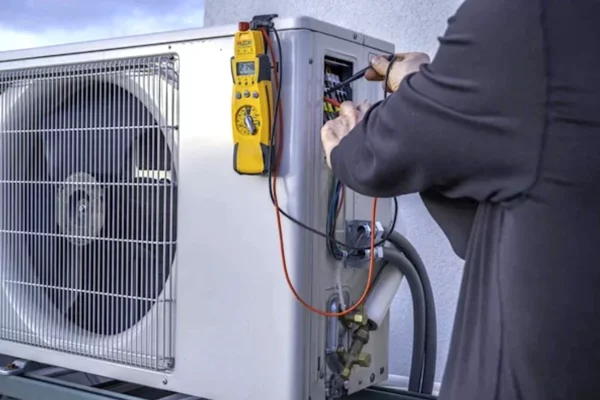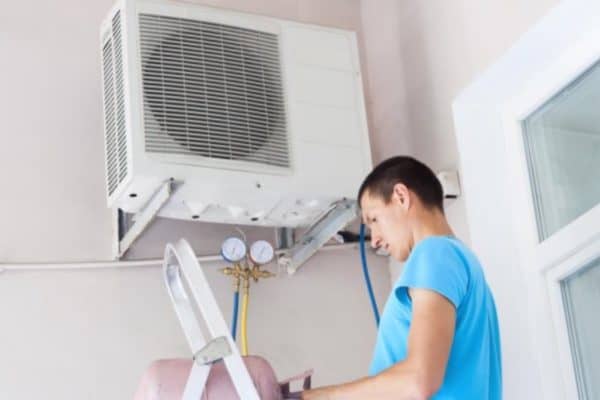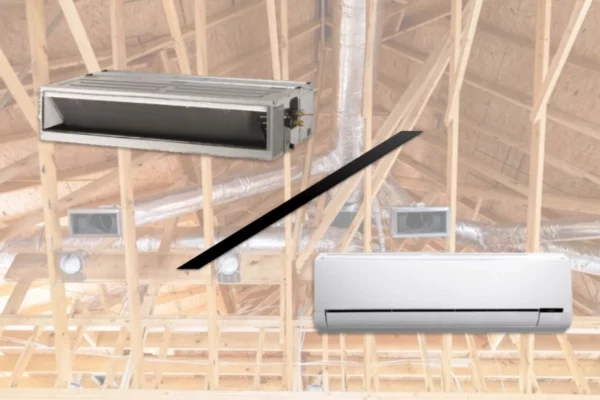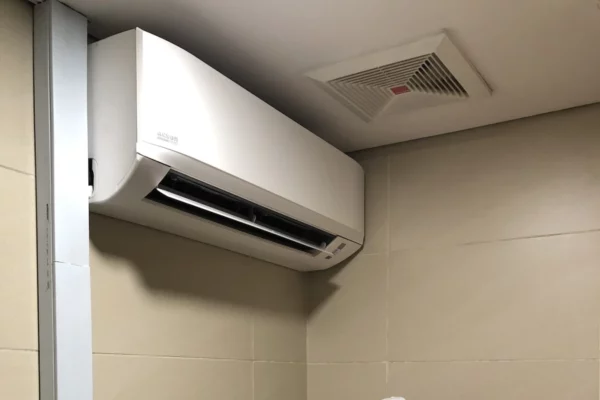Do Mini Splits Dehumidify and Remove Moisture?
High humidity in homes is causing mold and fungus to grow. Since mini splits are gaining popularity nowadays, many people are considering them. However, they are wondering do mini splits dehumidify? So, I decided to write a post to address it.
Mini splits do dehumidify. All mini splits are able to remove moisture from the air through the condensation process and discharge the condensate water via a drain pipe. A 12,000 BTU mini split is capable of dehumidifying the air from 75% relative humidity down to 45% relative humidity in one hour for a 170 square feet room.
Some people argued that mini splits are not good at drying the air but I would say that they did a pretty good job, at least for my bedroom.
How Mini Splits Dehumidify?
Mini splits dehumidify using the condensation process just like any other air conditioner. The cooling coil of the mini split indoor unit is chilled to below the dew point of air so that condensation can happen.
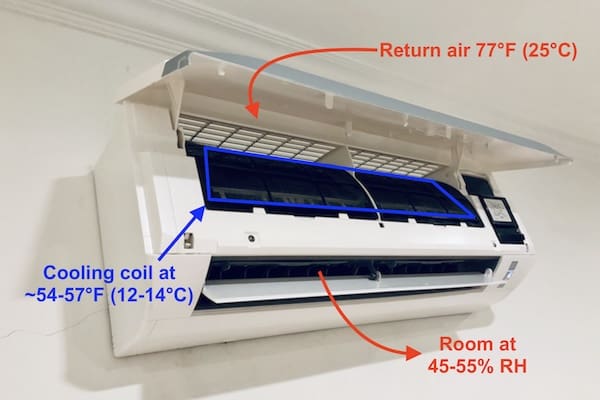
The key to enabling the condensation of air is to reduce the surface temperature of the cooling coil below the dew point of the air. Otherwise, the air won’t condensate.
With the same amount of moisture, warm air is able to hold more moisture than cold air. Thus, when we cool the warm air to a point where its moisture-holding capacity drop beyond the amount of moisture it originally had, the moisture will “overflow” and “leak out”. Therefore, condensation occurs and liquid water forms.
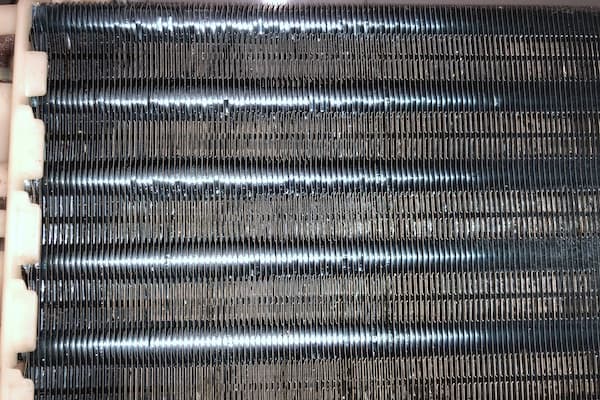
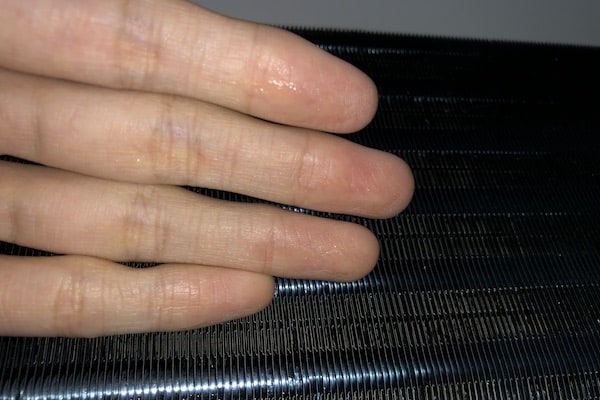
At the temperature where moisture starts to “overflow” out of the air is known as the dew point. In order for the cooling coil to reach the dew point, cold refrigerant is pumped into the cooling coil from the outdoor unit.
See more about the working principle of an air conditioner.
When the return air passes through the cooling coil, moisture is extracted out the air. Water droplets form on the surface of the cooling coil and fall onto the trench inside the mini split. The trench is slightly tilted so that the condensate water can flow naturally into the drain pipe. The drain pipe installed externally will guide the condensate water to the nearest floor trap or scupper drain.
Every time a mini split is turned on, the same process keeps on going. Through that, the mini split continues to dehumidify and reduce the moisture in the air as well as cool the air at the same time. That’s why mini splits need a drain pipe.
When the air is cold enough and the amount of moisture is low enough, the mini split is no longer able to dehumidify as it reached its limit. Usually, the room temperature will be around 75°F (24°C) and the relative humidity level will be around 45-50%.
Mini split is a great heating and cooling system. However, there are many brands and models. So, I did some study to come out the 4 Best Mini Splits in 2023. I encourage you to check it out if you’re considering one now.
Why Your Mini Splits are Not Dehumidifying?
The most common reason why a mini split fails to dehumidify the air to around 45-55% relative humidity is oversized. An oversized mini split has a cooling coil that is too big and the airflow is too much.
“Oversized air conditioners are the most common cause of high humidity in homes and buildings.”
The return air that passes through the cooling coil is not going to drop from 75% RH to 45% RH immediately. Instead, the air gradually loss moisture each time it is circulated through the mini split.
I’ve done an experiment where the result was my 12,000 BTU mini split reduced the humidity level in my 170 square feet bedroom from 75% RH to 45% RH in one hour.
When you have an oversized mini split, the air temperature gets cooled very quickly, leaving no time for moisture extraction. Hence, the air temperature may drop from 86°F (30°C) to 75°F (24°C) but the relative humidity may drop from 75% to 65% only.
How to Dehumidify More With an Oversized Mini Split?
If you unfortunately had an oversized mini split installed in your house, what can you do to bring down the humidity level?
Variable Speed Mini Splits
It’s very easy for an oversized mini split to reach about 45-55% relative humidity. Because most mini splits are variable speeds, simply set the temperature to 77-81°F (25-27°C) and the fan speed to the lowest possible setting.
Now, let your mini split run for an hour and you should be able to bring the humidity level down while not getting too cold.
The variable speed mini split can make the cooling coil stay around 61-64°F (16-18°C) which is just enough to keep the air condensate until around 55% relative humidity while not cooling your room too much.
However, if your mini split is a traditional on/off type where it cycles on and off based on your room temperature, its cooling coil will always stay around 50-54°F (10-12°C) no matter what temperature you set. With that, you either get too cold or too wet.
On/Off Mini Splits
On/off type mini splits will stop chilling the cooling coil entirely when the set temperature is reached. Thus, the moisture removal process also stops entirely.
In order to further reduce the humidity level, we need to force an on/off mini split to run its compressor and chill the cooling coil to bring back the moisture removal process.
First, set the temperature to the lowest possible setting and the fan speed to your comfort level (fan speed is not a concern now). Typically, the lowest temperature setting is 61°F (16°C) but the mini split won’t ever reach that low of a temperature unless it is massively oversized.
Thus, your mini split will keep running and dehumidify the air but your room soon will get very cold. Now, you can use a space heater to warm yourself up.
Doing so definitely will consume a crazy amount of electricity but it’s a temporary solution.
The long-term solution is to replace the oversized on/off mini split. As for the inverter or variable speed mini split, you may not need to replace it as long as it can reach 45-55% relative humidity.
What Does the Dry Setting Do on a Mini Split?
The dry mode setting on a mini split is meant to change the objective of the mini split from cooling to dehumidifying. Some mini splits have fixed settings when operating in dry mode. These settings are deemed to be the best setting for dehumidifying as per the manufacturer and you can’t alter them.
However, if you have an oversized mini split, using the dry mode may still not be able to bring the humidity level down. In addition, using the dry mode also cools the room which some people claimed that it won’t.
Is Dry Mode the Same as Dehumidifier?
A mini split in dry mode is not entirely the same as a dehumidifier. But, the principle is the same when it comes to removing moisture from the air.
The difference between a dehumidifier and a mini split in terms of moisture removal is that a dehumidifier can remove more moisture because its cooling coil is much colder and it uses a heater to bring the supply air temperature back up so that your room won’t be too cold.
As you can see, it’s the same as using a space heater to warm up your room while letting your mini split blast out the coldest air.
Key Takeaways
Mini splits do dehumidify and remove moisture from the air. Most mini splits reduce the humidity level down to around 45-55% relative humidity.
In order to dehumidify or reduce the moisture in the air, condensation must take place. In order for the air to condensate, it must be cooled to the dew point or beyond.
The reason why an oversized mini split is not able to dehumidify is that it cools too quickly, leaving no time for dehumidification.
One way to improve the dehumidification of an inverter mini split is to set a higher temperature and a lower fan speed as well as give time for it to remove the moisture in the air.
For an on/off mini split, set to the lowest temperature setting to force the compressor to run and start removing the moisture from the air. However, the room will be too cold and a space heater can help to warm it up.
Lastly, consider my Mini Split (eBook) if you want to know how can you use Mini Split in your house. If you still have doubt or not feeling confident enough, feel free to consult me.
Consultation Service
Ask me for HVAC advice such as brand selection, best model, benefits, features, placement, duct size, grille size, how to design, design check, verification and other HVAC related queries.
If you have anything to add (or ask) about this topic, leave a comment down below!




